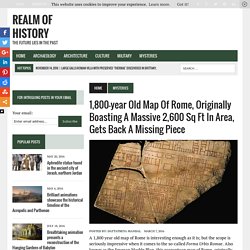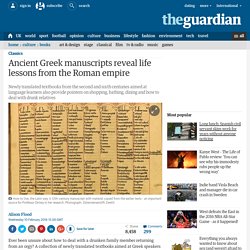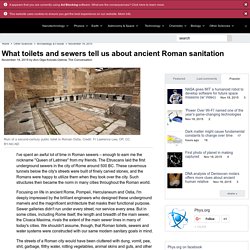

A 2nd century 007? Archaeologists discover barracks that may have been used by ancient Rome's secret service. A Five-Minute Guide to Medieval Fabrics. 40 maps that explain the Roman Empire. By Timothy B.

Lee on August 19, 2014 Two thousand years ago, on August 19, 14 AD, Caesar Augustus died. He was Rome's first emperor, having won a civil war more than 40 years earlier that transformed the dysfunctional Roman Republic into an empire. Under Augustus and his successors, the empire experienced 200 years of relative peace and prosperity.
Here are 40 maps that explain the Roman Empire — its rise and fall, its culture and economy, and how it laid the foundations of the modern world. The rise and fall of Rome The rise and fall of RomeIn 500 BC, Rome was a minor city-state on the Italian peninsula. The rise of Rome. ORBIS: The Stanford Geospatial Network Model of the Roman World. Collections. View the exclusive collection of items excavated at Vindolanda.

12 Renowned Roman Legions and How They Earned Their Names. READING ANCIENT ROMAN COINS. Trajan's Column - Reading an Ancient Comic Strip. Fulltext. Massive Map Of Rome, Older Than 1,800 Years, Gets A Missing Piece. A 1,800 year old map of Rome is interesting enough as it is; but the scope is seriously impressive when it comes to the so-called Forma Urbis Romae.

Also known as the Severan Marble Plan, this gargantuan map of Rome, originally made between the years 203-211 AD, measured a whopping 18.10 m x 13 m (or 60 ft x 43 ft). Here's what fruits and vegetables looked like before we domesticated them. Next time you bite into a slice of watermelon or a cob of corn, consider this: these familiar fruits and veggies didn't always look and taste this way.

Genetically modified foods, or GMOs, inspire strong reactions nowadays, but humans have been tweaking the genetics of our favourite produce for millennia. While GMOs may involve splicing genes from other organisms (such as bacteria) to give plants desired traits – like resistance to pests, selective breeding is a slower process whereby farmers select and grow crops with those traits over time. From bananas to eggplant, here are some of the foods that looked totally different before humans first started growing them for food. Wild watermelon Alvaro/Wikimedia Commons This 17th-century painting by Giovanni Stanchi depicts a watermelon that looks strikingly different from modern melons, as Vox points out. Modern watermelon. The USSR: A Short History. Ancient Greek manuscripts reveal life lessons from the Roman empire. Ever been unsure about how to deal with a drunken family member returning from an orgy?

A collection of newly translated textbooks aimed at Greek speakers learning Latin in the ancient world might hold the solution. Professor Eleanor Dickey travelled around Europe to view the scraps of material that remain from ancient Latin school textbooks, or colloquia, which would have been used by young Greek speakers in the Roman empire learning Latin between the second and sixth centuries AD. Eläimet saattavat kuoleman maahan. The Birth And Death Of Privacy: 3,000 Years of History Told Through 46 Images — The Ferenstein Wire. Increased urban density and skyrocketing rents in the major cities has put pressure on communal living.

“We’re seeing a shift in consciousness from hyper-individualistic to more cooperative spaces…We have a vision to raise our families together.” ~ Jordan Aleja Grader, San Francisco resident At the more extreme ends, a new crop of so-called “life bloggers” publicize intimate details about their days: How Much Water Reached Rome? (Courtesy Duncan Keenan-Jones, University of Glasgow) Anio Novus aqueduct, ItalyRome’s 11 aqueducts, some extending for more than 50 miles, transported enough water to feed the city’s 591 public fountains, as well as countless private residences.

Life before antibiotics (and maybe life after an antibiotic apocalypse) - BBC Newsbeat. What toilets and sewers tell us about ancient Roman sanitation. I've spent an awful lot of time in Roman sewers – enough to earn me the nickname "Queen of Latrines" from my friends.

The Etruscans laid the first underground sewers in the city of Rome around 500 BC. These cavernous tunnels below the city's streets were built of finely carved stones, and the Romans were happy to utilize them when they took over the city. Such structures then became the norm in many cities throughout the Roman world. Helsinki on täynnä bordellien jälkiä – maalaistyttöjen kehoista taisteltiin heti rautatieasemalla - Prostituutio - Kaupunki. Untitled. Ancient Rome was a cosmopolitan city, drawing in people and products from across the Mediterranean world and beyond.

By the late first century BC, there were as many as one million inhabitants in Rome, an urban population figure not reached again in the western world until London in around 1800. Suomalaisten pyhiinvaellukset keskiajalla. Sex Behind Closed Doors: Marriage, and the Invention of Privacy. Greek and Roman Armour Day - 20 July 2015. Upload Roman Society website Roman Society Loading...

Working... ► Play all Greek and Roman Armour Day - 20 July 2015 by Roman Society8 videos701 viewsLast updated on Aug 24, 2015 Play all Sign in to YouTube Sign in History Sign in to add this to Watch Later Add to Loading playlists...